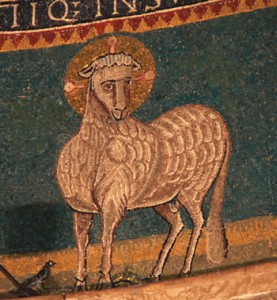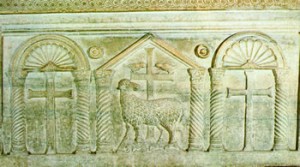Behold, the Lamb of God
According to John’s Gospel, one day when John the Baptist was standing talking to two of his disciples, he looked up and saw Jesus walking by and said to his disciples “Behold, the Lamb of God!” The disciples of the Baptist must have been puzzled by the remark, but they considered John a prophet and took what he said as significant, so they left him and walked after Jesus, wanting to meet the person that John had so cryptically identified.
As they walked they may have pondered the expression; “Lamb of God” is not a phrase from the scriptures that is associated with the Messiah. There is one verse in Isaiah (53:7) where the “Suffering Servant” is described as “Like a lamb that is led to slaughter”. Lambs were sacrificed in the Temple as a sin offering; a lamb that was to be offered to God, might be referred to as “lamb of God”, meaning “the holy lamb”. For the Jews, the most significant lamb of sacrifice is the one that was offered at Passover time. In the Exodus from Egypt, the firstborn sons of the Egyptians all died in the last of the ten plagues; only the homes of the Jews who had marked their doorposts with the blood of the lamb were passed over by the LORD (Exodus 12). In memory of that, each year, each Jewish family killed and ate a lamb, in memory of the time that they were saved by the blood of a lamb. The Passover lamb had to be a good one; you weren’t to pick the worst of your flock to give to God. Imagine a Jewish shepherd saying to his child “You see that white lamb on the edge of the flock, that’s the lamb of God.” – meaning that it was the one he had chosen for sacrifice.
What everyone agreed is that the lambs were hard done by in this! The lamb was, by definition, innocent and not deserving of a premature death. The lamb died so that others might be spared.
One of the great challenges for the first disciples of Jesus was making sense of his being crucified. If he truly was the Son of God why did he suffer and die? He hadn’t done anything wrong! Even the resurrection does not stifle this questioning, that Jesus rose from the dead does not make his suffering and dying any less real and problematic.
Jesus was taken down from the cross on that Friday because the Sabbath day that followed was the Passover day. John the Evangelist points out that Jesus was led away to be crucified at the same time that the Passover lambs were being slaughtered. That fitted with what Isaiah said about the suffering servant. Maybe it was the same two disciples who had followed John the Baptist who remembered his cryptic words “Behold, the Lamb of God!” and made the connection between the innocent Jesus and the lamb of Passover; linking his passing with the events of Exodus.
The first disciples of Jesus preached his death not as a defeat, but as a sacrifice that takes away the sins of the world. Their ideas crystallized around the phrase “Lamb of God” and from being something shameful the cross became their boast. St Paul could write (1Cor 1:22-24): “For Jews demand signs and Greeks desire wisdom, but we proclaim Christ crucified, a stumbling block to Jews and foolishness to Gentiles, but to those who are the called, both Jews and Greeks, Christ the power of God and the wisdom of God.”
Christian liturgy and art show just how powerful the image of Christ as “the Lamb of God” was for Christians. The Mystic Lamb is a common image in the catacombs, on the sarcophagi, and in the frescoes and mosaic designs, so much so that eventually Church authorities became worried that the symbol would cause confusion. A major Church Council taught: “We decree that the figure in human form of the Lamb who takes away the sin of the world, Christ our God, be henceforth exhibited in images, instead of the ancient lamb” (Canon 82 Quinisext Council 692 AD). Not everything decreed by a Church Council happens as they would wish. If you look for a lamb with a halo, often carrying the banner of the resurrection, you will find him in Church decoration, on vestments, sacred vessels, in liturgical books and Church bulletins throughout Christendom.
Our Eucharistic liturgy still echoes the prophetic words of John the Baptist; the host is elevated and the priest says “Behold, the Lamb of God” – we are to look and recognize the innocent victim whose death takes our sins away. When the two disciples of John who had heard those words, caught up with Jesus he turned and asked them “What are you looking for?” They said to him, “Rabbi, where are you staying?” So he said to them, “Come and see.”



 Entries(RSS)
Entries(RSS)